This is a writing application without distractions and fuss, easy to use and tiny.
Key Features
- Markdown support.
- Writing statistics: time, words count.
- Ambient music.
- Right to left support.
- Import and Export.
- Storage friendly.
- Favorite files.
- Search.
- Battery friendly.
- Markdown helper:
- H1, H2 and H3
- Bold, italic and strikethrough
- Quote
- List (bulleted and numbered)
- Link
- Image and video (Youtube)
Motivation
I wanted to learn and use new patterns and libraries on Android. On the one hand I wanted to use the new Android Design Support Library.
On the other hand, I wanted to try the new Android Architecture Components. They are a new collection of libraries that help design robust, testable, and maintainable apps.
When I saw the announcement on the Google I/O 2017 I was totally sure that I was going to try as soon as I could in my next project.
Finally, I also wanted to include in the application a background music player since I had never worked with anything like that on Android.
Concept
It must implement all the required features in an intuitive and transparent way. elaborate a mockup to follow in its development.
Before the development, I have developed a sketch mockup to test the different features and the user experience.

Implementation
The MainActivity is the entry point of the application and shows all available documents in a grid. To do this, it uses a RecyclerView. There is a bottom toolbar that appears when any document is selected. It is possible to change the order and filter.
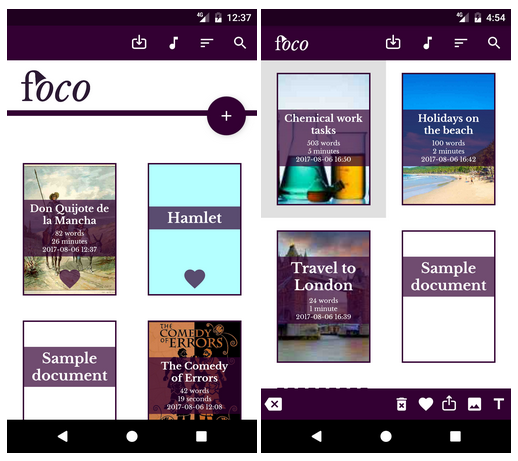
The EditDocActivity is where the user can edit a document and visualize its preview. The CustomEditText view has been used for editing. This class extends EditText and adds the functionality to add a listener to receive the selection change events. This was necessary to be able to offer a bottom toolbar with markdown format editing shortcuts.
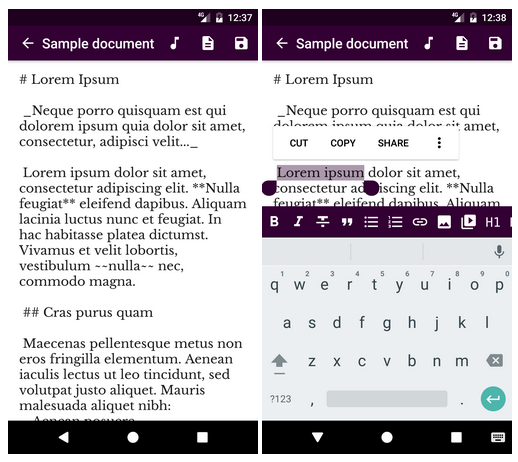
For the preview has been used MarkdownView that is a view defined in a third-party library with the same name. It is very useful since it is easy to use and very powerful. It supports several markdown formats and nice CSS themes.
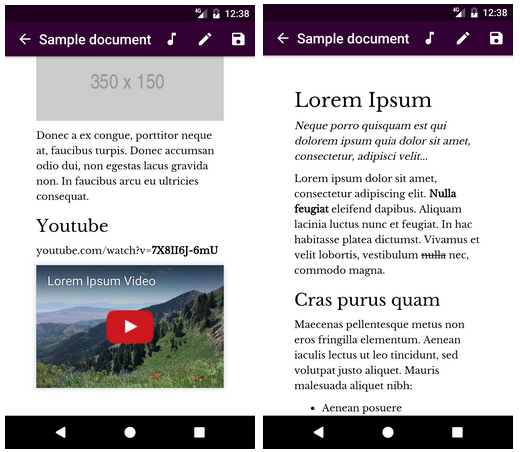
The cover of a document can be a flat color or a custom image. The EditDocCoverDialog implements this cover settings. It could be presented as a dialog or as a full screen fragment depending on the device.
The view of this dialog has two tabs. The first one shows the selected cover color and it can be modified using the Material Color Picker Dialog. The second one shows the selected cover image and it can be modified using File Picker Dialog. It is executed a post-selection process of the image to reduce and optimize it. It achieves it by using the Picasso and the Compressor libraries.
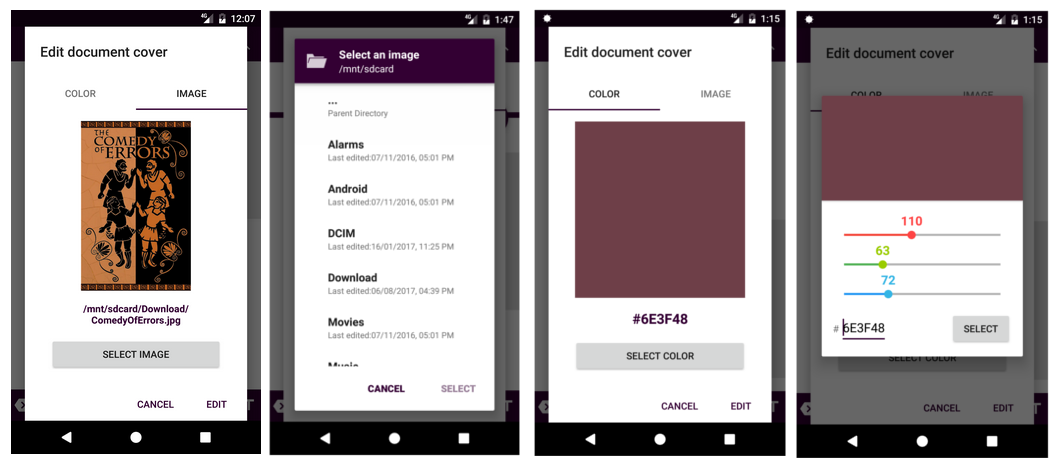
The MusicDialog shows a simple ambient music control. It is connected to the MusicService to retrieve playback information and to perform actions.
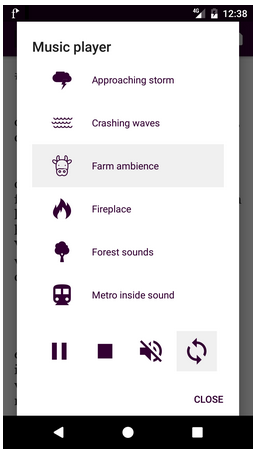
The MusicService is a bound service. It is responsible for managing the playback of the ambient music. It uses a MusicPlayer. The ambient music are pre-stored tracks to play in a loop. It is possible to interact with this service through intent actions and its bind interface.
The service manages and controls a notification while there is music playing. This notification has actions that use PendingIntent to control the playback.
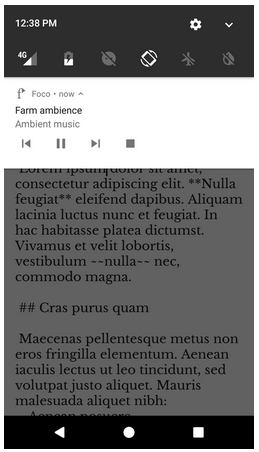
Android Architecture Components
I used of Room for the data persistence. Room provides an abstraction layer over SQLite to allow fluent database access while taking advantage of the powerful SQLite. There is a Data Access Object (DAO) interface called DocumentDao. For example, it has this method to get a document:
| |
There is an Entity class called DocumentEntity. It implements the Document interface from the domain and it has all attributes column names defined there. The DocumentMetadata class contains all attributes of DocumentEntity but the text of the document. This is useful in order to retrieve a list of documents avoiding loading in memory each document. Room deals with any class that it could match the column names with class attributes. For example, to get a document metadata the DocumentDao method is:
| |
The database that stores this DAO is defined in the AppDatabase. It is singleton with the purpose of accessing and creating the database. The instance is created by using Room:
| |
The DocListViewModel, that extends the ViewModel class, manages the access of the data from the view classes attached to the Android life cycle. It offers a LiveData that contains a list of DocumentMetadata. In order to consume the DocListViewModel I had to do the following:
| |
As you can see, it is no longer necessary to mess with AsyncTask to load the data asynchronously nor manual cache to avoid load the data again with configuration changes. These new components own that complexity in a transparent way.
Dependencies
The 3rd party software that I have used for the application is:
- Butter Knife: Bind Android views and callbacks to fields and methods.
- Timber: A logger with a small, extensible API which provides utility on top of Android’s normal Log class.
- Picasso: A powerful image downloading and caching library for Android.
1 2 3 4 5 6 7 8Picasso.with(getActivity()) .load(new File(mImagePath)) .placeholder(R.drawable.image_placeholder) .memoryPolicy(MemoryPolicy.NO_CACHE) .resize(IMAGE_MAX_WIDTH_PX, IMAGE_MAX_HEIGHT_PX) .centerInside() .onlyScaleDown() .into(mImageView); - Material Color Picker Dialog: A simple, minimalistic and beautiful dialog color picker.
1 2 3 4 5 6 7 8 9 10 11final ColorPicker cp = new ColorPicker(getActivity(), Color.red(currentColor), Color.green(currentColor), Color.blue(currentColor)); cp.show(); cp.setCallback(new ColorPickerCallback() { @Override public void onColorChosen(@ColorInt int color) { // do something ... } }); - FilePicker: A simple and minimalistic file picker dialog.
1 2 3 4 5 6 7 8 9 10DialogProperties properties = new DialogProperties(); ... FilePickerDialog dialog = new FilePickerDialog(getActivity(), properties); dialog.setDialogSelectionListener(new DialogSelectionListener() { @Override public void onSelectedFilePaths(String[] files) { // do something ... } }); dialog.show(); - Compressor: An Android image compression library.
1 2 3 4 5 6 7File compressedImage = new Compressor(getActivity()) .setMaxWidth(IMAGE_MAX_WIDTH_PX) .setMaxHeight(IMAGE_MAX_HEIGHT_PX) .setQuality(IMAGE_QUALITY) .setCompressFormat(Bitmap.CompressFormat.JPEG) .setDestinationDirectoryPath(directory.getAbsolutePath()) .compressToFile(new File(image), name); - MarkdownView: An Android library to display markdown text in a beautiful way.
Conclusion
Thanks to this project I have been able to learn a lot. I liked working with the new Android Architecture Components and in my opinion they have a great future ahead.
The result is very close to the initial mockup and most of the features are implemented. I think it meets the requirements and I hope it is useful.
The application is free software, GPLv3, you can see the code on GitHub and download the APK from the Releases page.